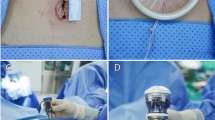Abstract
Objective
To compare clinical and effectiveness outcomes between robotic-assisted laparoscopic myomectomy (RALM) and abdominal myomectomy (AM).
Study design
Records were reviewed for the first 27 RALM procedures at our institution. Age, BMI, insurance status, race, uterine size, and operative indication were used to select comparable patients who had undergone AM. Clinical and efficiency outcomes were compared stratifying for uterine size, specimen weight, and matched propensity scores.
Results
IV hydromorphone use was significantly lower for RALM (P < 0.01), with no significant differences in blood loss or complications. RALM patients had significantly shorter hospital stays; however, total hospital charges were higher (P < 0.0001). This likely reflects longer operating room time (P < 0.0001), which was magnified as specimen size increased (P < 0.0001).
Conclusion
RALM patients require less IV hydromorphone, have shorter hospital stays, and have generally equivalent clinical outcomes compared with AM patients. Additionally, as specimen size increased, the operative efficiency of RALM decreased compared with AM.

Similar content being viewed by others
References
Management of Uterine Fibroids. Summary, Evidence Report/Technology Assessment: Number 34. AHRQ Publication No. 01-E051, January 2001. Agency for Healthcare Research and Quality, Rockville, MD, USA. http://www.ahrq.gov/clinic/epcsums/utersumm.htm (Accessed 3/7/2005).
Holzer A, Jirecek ST, Illievich UM, Huber J, Wenzl RJ (2006) Laparoscopic versus open myomectomy: a double-blind study to evaluate postoperative pain. Anesth Analg 102(5):1480–1484
Parker WH, Iacampo K, Long T (2007) Uterine rupture after laparoscopic removal of a pedunculated myoma. J Minim Invasive Gynecol 14(3):362–364
Banas T, Klimek M, Fugiel A, Skotniczny K (2005) Spontaneous uterine rupture at 35 weeks’ gestation, 3 years after laparoscopic myomectomy, without signs of fetal distress. J Obstet and Gynaecol Res 31(6):527–530
Barakat EE, Bedaiwy MA, Zimberg S, Nutter B, Nosseir M, Falcone T (2011) Robotic-assisted, laparoscopic, and abdominal myomectomy: a comparison of surgical outcomes. Obstet and Gynecol 117(2):256–266.
Advincula AP, Xu X, Goudeau St, Ransom SB (2007) Robot-assisted laparoscopic myomectomy versus abdominal myomectomy: a comparison of short-term surgical outcomes and immediate costs. J Minim Invasive Gynecol 14(6):698–705
Ascher-Walsh CJ, Capes TL (2010) Robot-assisted laparoscopic myomectomy is an improvement over laparotomy in women with a limited number of myomas. J Minim Invasive Gynecol 17(3):306–310
Rosenbaum PR (1989) The role of known effects in observational studies. Biometrics 45(2):557–569
Yuen PM, Yu KM, Yip SK, Lau WC, Rogers MS, Chang A (1997) A randomized prospective study of laparoscopy and laparotomy in the management of benign ovarian masses. Am J Obstet Gynecol 177(10):109–114
Barbash GI, Glied SA (2010) New technology and health care costs–the case of robot-assisted surgery. N Engl J Med 363(8):701–704
Bocca S, Stadtmauer L, Oehninger S (2007) Uncomplicated full term pregnancy after DaVinci-assisted laparoscopic myomectomy. Reprod Biomed Online 14(2):246–249
Hu JC, Gu X, Lipsitz SR et al (2009) Comparative effectiveness of minimally invasive vs open radical prostatectomy. JAMA 302:1557–1564
Acknowledgments
The authors would like to thank Markus Zei of Northwestern University Feinberg School of Medicine for assistance with medical records review, Mary Mueller of the Northwestern Memorial Hospital Financial Planning Department for data acquisition, and the faculty and staff of the Research & Education for Academic Achievement (REACH) Network for their support. The authors would also like to thank Northwestern University Clinical and Translational Sciences Institute (NUCATS) for their support in part for grant funding by NIH (grant UL1RR025741) and the Evergreen Invitational Grand Prix Women’s Health Grants Initiative.
Conflict of interest
We declare that we have no conflict of interest. Also, we have had full control of all primary data and agree to allow the Journal to review data if requested.
Author information
Authors and Affiliations
Corresponding author
Rights and permissions
About this article
Cite this article
Nash, K., Feinglass, J., Zei, C. et al. Robotic-assisted laparoscopic myomectomy versus abdominal myomectomy: a comparative analysis of surgical outcomes and costs. Arch Gynecol Obstet 285, 435–440 (2012). https://doi.org/10.1007/s00404-011-1999-2
Received:
Accepted:
Published:
Issue Date:
DOI: https://doi.org/10.1007/s00404-011-1999-2




